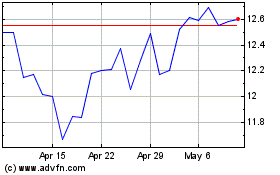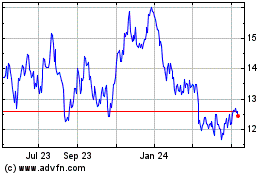Brazil's Vale Cuts Waste Storage Expenditures
October 28 2016 - 12:07PM
Dow Jones News
By Paul Kiernan
RIO DE JANEIRO -- Brazilian mining giant Vale SA has slashed
spending on waste storage even after a catastrophic dam failure at
its Samarco joint venture last November killed 19 people and
triggered tens of billions of dollars in lawsuits.
Vale, the world's largest producer of iron ore and nickel,
reduced maintenance capital expenditures on waste dumps and
tailings dams by 51% in the first nine months of 2016 from the
year-ago period to $86.7 million, according to its financial
statements. That followed similarly large cuts in 2014 and 2015 as
Vale doubled down on belt-tightening measures in a bid to shore up
cash reserves and pay down debt amid the commodity downturn.
The company didn't immediately respond to requests for comment
on the spending cuts, which were substantial even after accounting
for a weaker Brazilian currency.
Inadequate maintenance of mining waste can be disastrous. The
collapse of Samarco's Fundão tailings dam in southeast Brazil
released at least 32 million cubic meters of mine detritus --
enough to fill the Dallas Cowboys' AT&T Stadium 11 times --
which destroyed villages and polluted more than 400 miles of rivers
before spewing into the Atlantic Ocean.
Vale and joint-venture partner BHP Billiton Ltd. are defendants
alongside Samarco in a nearly $50 billion environmental lawsuit
filed by Brazilian prosecutors as a result of the damage. Federal
prosecutors also charged 21 officials from the three companies with
homicide last week, alleging that they repeatedly put economics
ahead of safety by continuing to deposit waste into Fundão after it
developed chronic structural problems as far back as 2009.
Citing internal company documents, prosecutors said Samarco
reduced by 29% the budget for its division responsible for dam
management between 2012 and 2015, a period in which mine output --
and tailings -- rose.
"A severe regime of continuous reduction in spending on dam
safety was discovered," federal prosecutors wrote in the 272-page
charge sheet filed last week. "The search for cost cuts was
incessant."
Vale's output has also risen steadily in recent years. The
company expects to produce at least 340 million metric tons of iron
ore this year, up from 300 million tons in 2013, when it budgeted a
whopping $809 million for tailings dams and waste dumps. Production
of copper and nickel, two other metals that generate substantial
volumes of waste, is set to rise 28% and 25%, respectively, from
2013 levels.
Some of Vale's savings on tailings disposal likely came from an
agreement with Samarco whereby it was allowed to deposit so-called
"slimes" -- or fine-grained mine waste -- from its nearby Alegria
iron-ore mine into Fundão. Slimes are considered a particularly
risky form of tailings because they drain poorly and are less
stable than a coarser type of waste known as "sands," engineers
say.
Vale accounted for 27% of the volume of slimes in Fundão.
Prosecutors say this likely accelerated the dam's collapse, which
an official review panel partly attributed to the fact that a
section of the dam's embankment rested directly on top previously
deposited slimes.
The dam's original design called for sands and slimes to be
strictly separated in the dam.
"Slimes from Vale had a large influence on the rising level of
the reservoir," the prosecutors said. "Without its
contribution...the level of the slimes reservoir wouldn't have
surpassed the level of the sands reservoir, causing the mud to
advance over sandy tailings."
Vale and BHP Billiton say they weren't responsible for the
Fundão accident because Samarco was independently operated. Samarco
has said it didn't know the dam was at imminent risk of failure.
The three companies have committed to remediating the damage.
Both BHP Billiton and Vale have had previous spills. BHP
Billiton withdrew from Papua New Guinea in 2002 after finding that
waste from its Ok Tedi copper mine, which was being dumped into a
local river for lack of a cost-effective alternative, had caused
widespread environmental damage. BHP Billiton Chief Executive
Andrew Mackenzie said last year that his firm helped clean up the
damage from Ok Tedi's tailings by creating a sustainable
development fund when it left.
In 2009, Vale's Alunorte alumina refinery in the Brazilian
Amazon leaked a toxic waste product known as red mud into a local
river.
Alunorte attributed the incident to a "1,000-year rain." Vale
sold the operation, which is the largest alumina refinery in the
world, to Norsk Hydro ASA in 2011.
Write to Paul Kiernan at paul.kiernan@wsj.com
(END) Dow Jones Newswires
October 28, 2016 11:52 ET (15:52 GMT)
Copyright (c) 2016 Dow Jones & Company, Inc.
Vale (NYSE:VALE)
Historical Stock Chart
From Mar 2024 to Apr 2024

Vale (NYSE:VALE)
Historical Stock Chart
From Apr 2023 to Apr 2024
